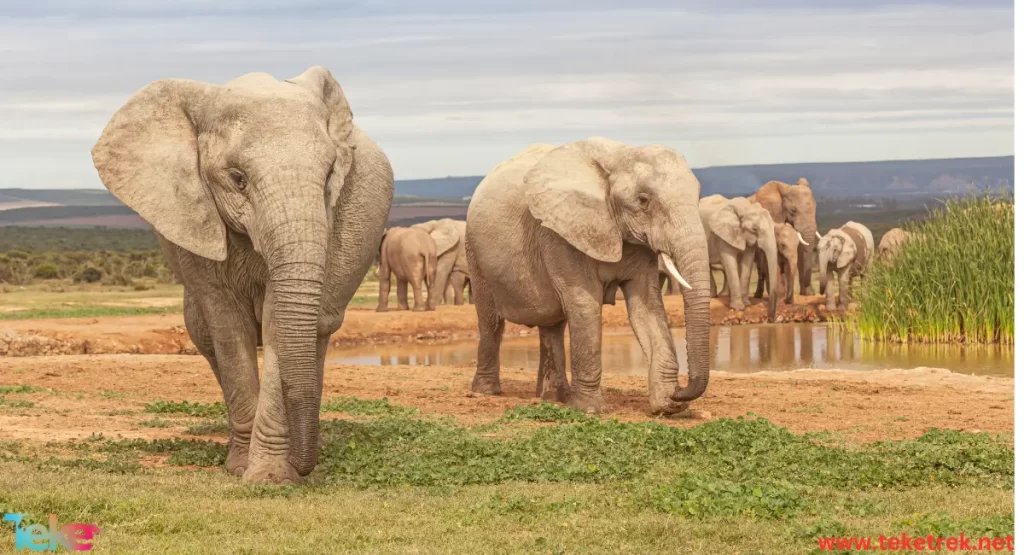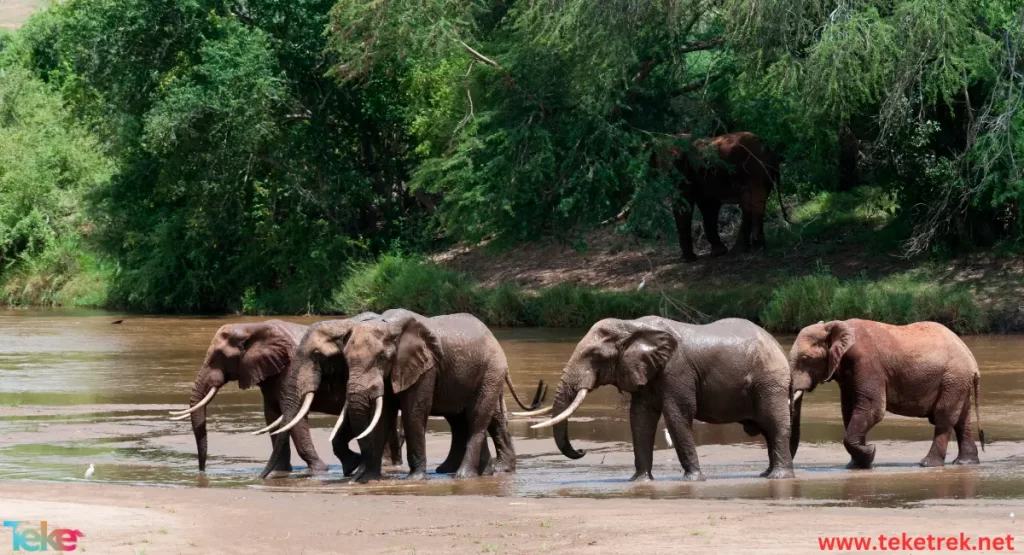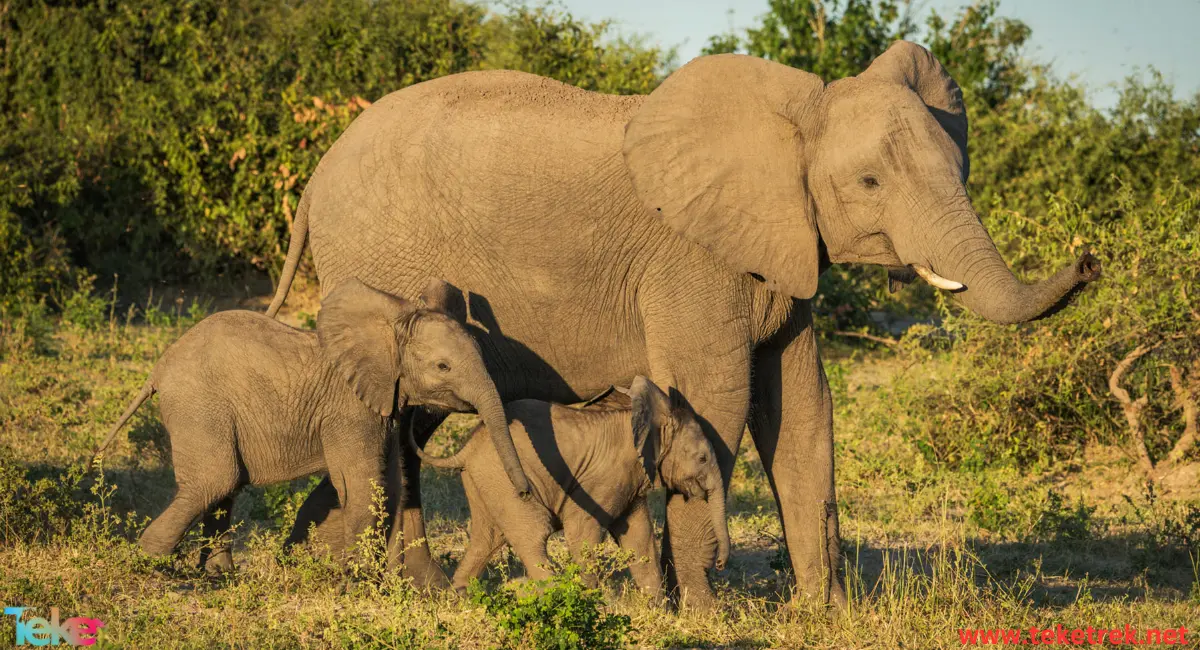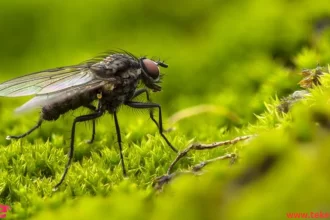The African elephant is one of the largest land mammals on Earth, and is considered a symbol of strength and pride in many cultures around the world.
The African elephant is distinguished by its huge body, large ears, and long trunk, which it uses to search for food and drink water.
The African elephant lives in groups called “herds.” These groups are characterized by advanced social organization and effective communication among their members, as females play an important role in leading the herd. While at a certain stage of his life, the male remains alone or joins small herds
Let’s explore more about these fascinating creatures from teke trek.

About theAfrican elephant
African elephant, scientific name (Loxodonta), the African elephant belongs to the phylum Omniformes, the phylum of vertebrates, of the class of mammals.
The African elephant has gray skin and is distinguished by the size of its tusks and ears, and the shape and size of its skull.
Types of African elephant
This genus consists of two species of living elephants:
African bush elephant or savannah elephant (L. africana):
This elephant is distinguished by its large size and noticeably curved outward tusks. It also roams the plains of Africa and sub-Saharan Africa.
Lesser African forest elephant or African bush elephant (L. cyclotis):
It is smaller in size and has straighter fangs, and lives in the forests of Central and West Africa.
African elephant habitat
African elephants are widely distributed in sub-Saharan Africa, deserts, coastal lowlands, in addition to woodlands rich in mopane and miombo trees and dense forests.
The characteristics of the African elephant
The African elephant is the largest land animal found on land. It is distinguished by its large body, large ears, and long trunk, which is used for eating, drinking, and communicating.
This elephant is considered one of the ancient mammals that live in the diverse regions of Africa in terms of environment and climate.
African elephant diet
African elephants feed on a vegetarian diet consisting of fruits such as wild apples, dates, bananas and roots, as well as grasses and leaves. African elephants consume large quantities of grasses and green plants on a daily basis to meet their essential nutritional needs.
African elephants need large amounts of water on a daily basis for cooling and drinking, and they may travel long distances to find the water resources they need. If these elephants have access to adequate food and water resources in their natural habitat, they can live healthy and sustainable lives.
Mating in the African elephant
The mating process in the African elephant takes place in a distinctive way. The male usually begins to advance towards the females of the herd with calm and gentle movements, and shows signs of interest and friendliness. If the female accepts the male as a mating partner, the male develops an erection and begins penetration.
The mating process lasts for several minutes to hours, and depends on various factors such as environmental conditions and the compatibility of the couple. After mating, the female African elephant’s pregnancy period lasts for 22 to 24 months before she gives birth to her calf.
The African elephant is often born weighing between 90 and 120 kilograms, and lives with its mother in the herd for a long period before it becomes able to survive on its own.
Is the African elephant a social animal?
Yes, the African elephant usually lives in social groups called “herds,” and females are often the leaders in these groups.
The herd consists of females and their young, and may sometimes include males. The females of the herd work together to protect the young and defend the group from dangers, such as predatory lions. They also exchange information and help in searching for water and food.
Females’ appreciation for leadership in an elephant herd is due to their ability to communicate effectively and understand each other’s needs. Females have strong social abilities that help them make collective decisions for the benefit of the entire group.

The most important threats and predators of the African elephant
The African elephant faces many threats and predators that negatively affect its numbers and environment.
The most important threats and predators facing the African elephant are:
1. Illegal hunting: The African elephant is subjected to illegal hunting for commercial purposes, such as the ivory industry. This hunting leads to a significant decline in elephant numbers.
2. Animals losing their natural habitats: Transformations in land use and degradation of natural habitats cause animals to lose their natural habitats, leading to the dispersal and weakening of elephant numbers.
3. Climate changes: The effects of climate changes, such as rising temperatures and lack of water resources, can negatively affect elephant numbers and their ability to survive.
4. Collisions with humans: Elephants are exposed to collisions with humans as a result of urban and agricultural expansion, which leads to collisions and injuries to elephants and humans alike.
5. Natural predators: The African elephant faces natural predators such as lions and tigers, which may attack weak individuals such as children or the elderly.
The protection of the African elephant requires continuous efforts to reduce these threats and risks, and ensure that it remains an essential part of Africa’s biodiversity.
The African elephant role in relation to the environment and ecosystem
The African elephant plays a vital role in the environment and ecosystem, for several reasons, including:
1. Its effect on plants: The African elephant is considered one of the largest plant eaters in the prairies, as it feeds on a wide range of herbs and trees, which leads to regulating the growth of plants and preserving their biological diversity.
2. Its effect on the soil: Thanks to its proper digestion of plant fibers, the elephant can contribute to renewing the soil and increasing its fertility through its secretions and urine.
3. Its impact on wildlife: The elephant is considered a predatory animal, as it plays an important role in the balance of the food chain in the area in which it lives.
4. Its impact on natural spaces: The presence of the elephant contributes to creating its surrounding environment, as it creates corridors and movement paths for other animals, and contributes to shaping the landscape.
In general, the African elephant is considered an essential part of the ecosystem in Africa, and protecting and preserving it contributes to the sustainability of the environmental balance and the preservation of wildlife diversity.
FAQs about the African elephant
- Is the African elephant extinct?
Yes, it is an endangered species
- What does the African elephant eat?
The African elephant eats plants such as shrubs, fruits, herbs, and branches, knowing that tree bark is its favorite food.
How much does an African elephant weigh?
The weight of an adult male ranges from 1,800 to 6,300 kg
- How many African elephants are left؟
there are approximately 415,000
- What is special about African elephants?
Ther are landscape architects.
Ultimately, The African elephant faces serious threats to the survival of these magnificent creatures on Earth, such as poaching and habitat destruction. We must all work to protect these magnificent creatures and preserve the diversity of life on our planet.
we must realize the importance of preserving the African elephant and protecting it from the threats it faces. The elephant is not just a wild animal, it is an integral part of the balance of the ecosystem and the diversity of life on our planet.
If we can preserve these great creatures, we preserve part of our natural heritage and ensure the continuity of life on Earth for future generations. So, let us all unite to protect African elephants and work to educate people about the importance of preserving these magnificent creatures before it is too late





